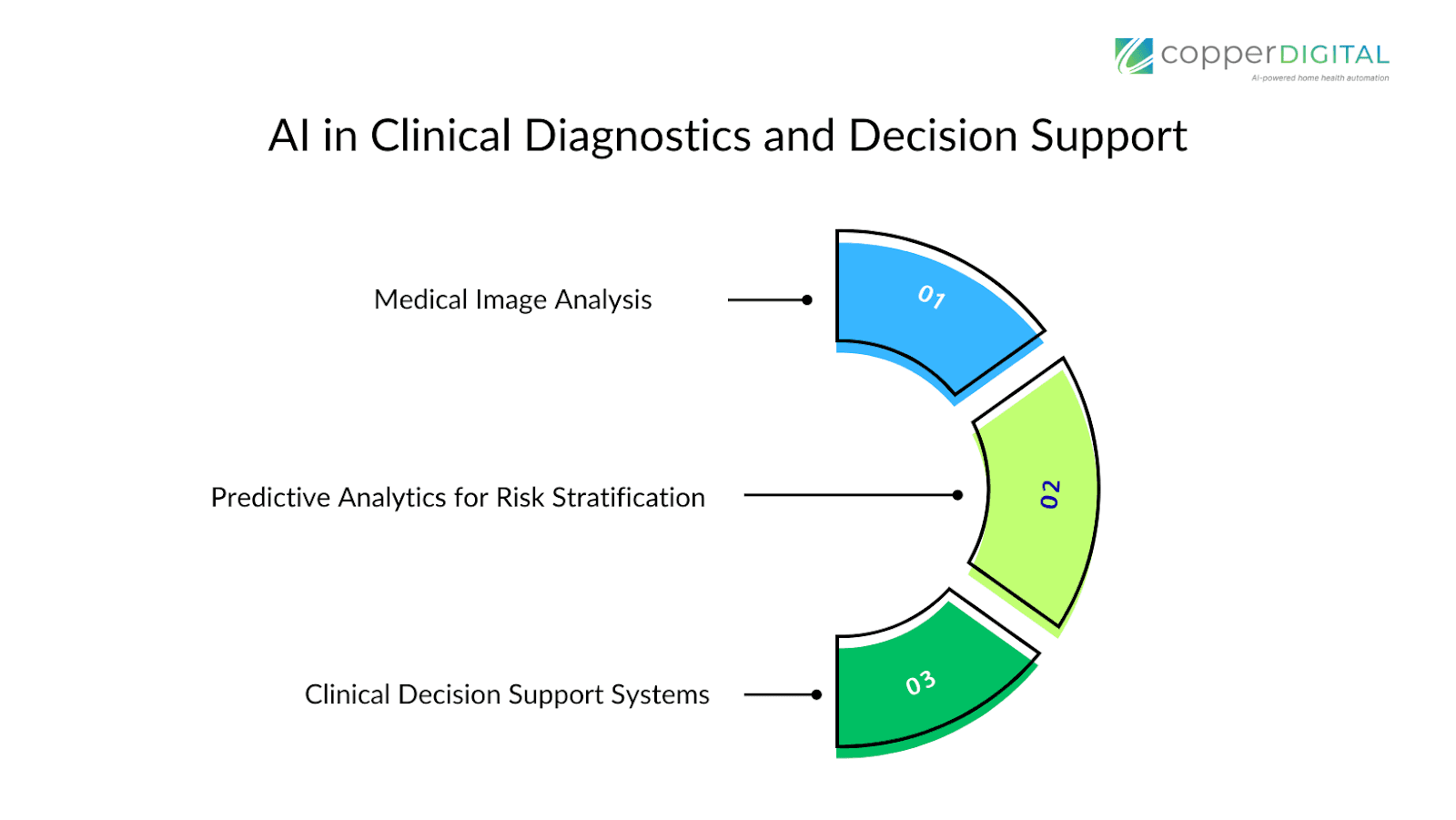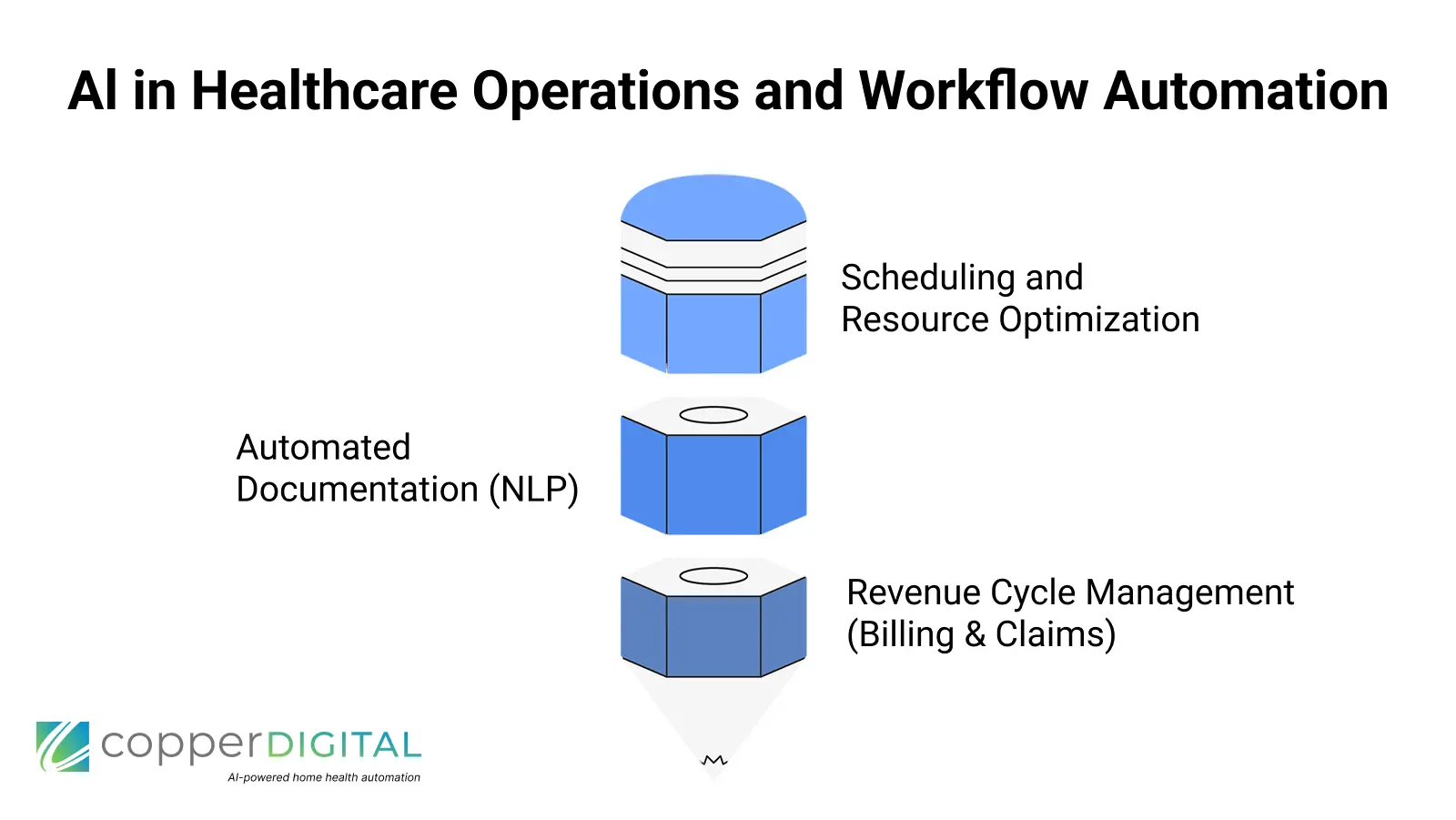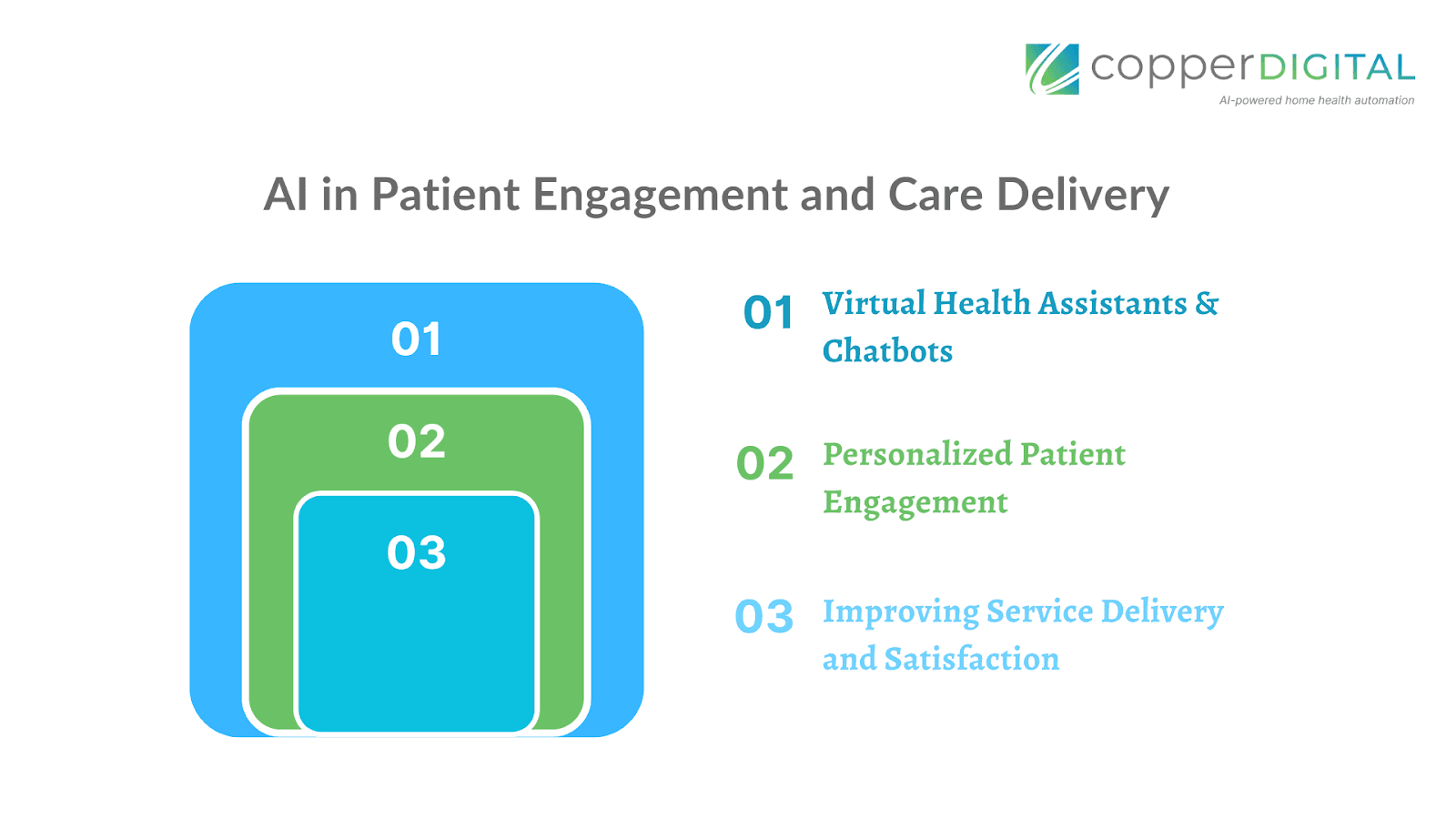Blog
Oct 5, 2025
What type of AI is used in Healthcare: A Comprehensive Guide for Healthcare Leaders

Arvind Sarin
Introduction: AI’s Growing Role in Healthcare
Artificial Intelligence is rapidly transforming healthcare by improving both clinical outcomes and operational efficiency. Across the industry, AI tools are saving time, reducing errors, and cutting costs – with potential savings of up to $150 billion annually in the U.S. alone. Hospitals and health systems are increasingly adopting AI-driven solutions to address critical challenges: from alleviating administrative burdens on staff to enhancing diagnostic accuracy and patient care. In fact, nearly 94% of healthcare organizations report using AI or machine learning in some capacity as of 2025. For healthcare executives, technical decision-makers, and clinical leaders, understanding the key types of AI in use today is essential for leveraging these technologies effectively. Below, we explore the main categories of AI in healthcare – and how each is delivering value in real-world settings.
AI in Clinical Diagnostics and Decision Support
One of the most impactful uses of AI in healthcare is in clinical diagnosis and decision support. Machine learning algorithms – especially in areas like medical imaging and predictive analytics – are augmenting clinicians’ capabilities:

Medical Image Analysis (Computer Vision)
AI systems can analyze radiology images (X-rays, MRIs, CT scans) with remarkable accuracy. For example, researchers at Massachusetts General Hospital and MIT developed an AI that detects lung nodules on scans with 94% accuracy, compared to 65% for human radiologists. Similarly, AI models have demonstrated higher sensitivity in detecting breast cancer on mammograms (90% vs. 78% for experts). These tools act as a “second set of eyes,” catching subtle anomalies that clinicians might miss, and thus help reduce diagnostic errors and improve early detection of diseases.
Predictive Analytics for Risk Stratification
Predictive Analytics for Risk Stratification: Beyond imaging, AI is used to predict patient risks and outcomes by analyzing large datasets from electronic health records and wearables. Machine learning models can flag high-risk patients for conditions like sepsis, heart failure, or diabetes complications before symptoms escalate. For instance, AI-driven algorithms have been able to identify early signatures of diseases (like Alzheimer’s or kidney disease) years in advance by mining patterns in patient data. This predictive power enables providers to intervene proactively – improving patient outcomes and potentially lowering the cost of care through prevention.
Clinical Decision Support Systems
Beyond imaging, AI is used to predict patient risks and outcomes by analyzing large datasets from electronic health records and wearables. Machine learning models can flag high-risk patients for conditions like sepsis, heart failure, or diabetes complications before symptoms escalate. For instance, AI-driven algorithms have been able to identify early signatures of diseases (like Alzheimer’s or kidney disease) years in advance by mining patterns in patient data. This predictive power enables providers to intervene proactively – improving patient outcomes and potentially lowering the cost of care through prevention.
It’s important to note that AI in clinical roles works best as an augment to human expertise rather than a replacement. These systems excel at pattern recognition and handling data at scale, while human providers still lead in judgment for nuanced or complex cases. When doctors and AI tools work together, studies have shown improved diagnostic accuracy and faster decision-making, ultimately benefiting patient care. Source:upskillist.com
AI in Healthcare Operations and Workflow Automation

Another major category of healthcare AI is aimed at streamlining administrative and operational workflows. Healthcare executives and managers are turning to AI-driven automation to reduce the heavy administrative workload on staff, improve efficiency, and cut costs. Key applications include:
Automated Documentation (NLP)
Natural Language Processing (NLP) algorithms can transcribe and summarize clinical notes, freeing clinicians from excessive typing. For example, AtlantiCare (a large healthcare system in New Jersey) implemented an AI “clinical assistant” that listens to doctor-patient conversations and drafts visit notes automatically. The results were striking – providers saw a 41% reduction in documentation time, saving about 66 minutes per day on paperwork. Doctors could “type less and listen more,” leading to both operational gains and improved patient satisfaction. This kind of ambient clinical documentation AI not only cuts down after-hours charting (reducing burnout), but also ensures records are updated promptly and accurately. Source: oracle.com
Scheduling and Resource Optimization
AI is also used to optimize staff scheduling, appointment slots, and resource allocation in hospitals. Machine learning models can predict no-show rates or peak patient volumes and adjust schedules accordingly, ensuring adequate staffing and reduced wait times. Intelligent scheduling systems can consider myriad factors (provider availability, patient preferences, urgency, etc.) and find optimal arrangements much faster than manual methods. Early adopters report improvements in operational efficiency by using AI to optimize scheduling and workflows, which ultimately means patients get seen sooner and staff workloads are balanced. In an environment like a home health agency or busy hospital, these efficiency gains translate to better service delivery and cost savings.
Revenue Cycle Management (Billing & Claims)
A particularly high-impact area for automation is billing and claims processing. Hospitals lose significant revenue due to claim denials and billing errors each year. AI tools are now helping on this front in several ways:
Automated Coding
NLP-based coding assistants can read clinical documentation and assign billing codes (ICD-10, CPT) automatically, reducing human coding effort and errors. Copper Digital extends this capability through its CopperOne™ Billing Agent, which not only automates code assignment but also embeds real-time compliance checks and eligibility verification. This proactive approach reduces coding errors at the source and significantly cuts claim rejections, ensuring faster reimbursements and healthier revenue cycles for providers.
Claim Scrubbing
AI systems can review claims before they are submitted to insurers, checking for mistakes or missing information. This proactive “scrubbing” catches errors that would otherwise lead to denials. According to the American Hospital Association, such AI-driven pre-submission checks can significantly reduce denial rates by flagging issues upfront.
Claim Scrubbing
AI systems can review claims before they are submitted to insurers, checking for mistakes or missing information. This proactive “scrubbing” catches errors that would otherwise lead to denials. According to the American Hospital Association, such AI-driven pre-submission checks can significantly reduce denial rates by flagging issues upfront.
Denial Prediction & Management
Machine learning models analyze past denial patterns to predict which claims are likely to be denied. Revenue cycle teams can then address these high-risk claims (e.g. verify coverage or obtain pre-authorizations) before submission. One health network in California deployed an AI tool to do this and achieved an 18–22% reduction in certain types of claim denials, without needing extra staff. Moreover, some systems can even draft appeal letters for denied claims using generative AI, accelerating the appeals process. Source: aha.org
These operational AI applications have a direct impact on a healthcare organization’s bottom line. By cutting down manual admin tasks, AI allows medical staff to focus more on patient care and less on paperwork. As a bonus, efficiency improvements often translate into financial savings. For example, roughly 46% of hospitals are already using AI in their revenue cycle operations, reflecting its value in reducing overhead costs and speeding up reimbursements. In short, AI-driven workflow automation addresses the pain points of high administrative costs and workforce burnout, making healthcare operations more agile and cost-effective.
AI in Patient Engagement and Care Delivery
Healthcare isn’t just about back-end efficiency – it’s ultimately about the patient. AI technologies are increasingly being used to enhance patient engagement, access to care, and overall experience. For decision-makers aiming to improve service quality and patient satisfaction, these AI applications are especially compelling:

Virtual Health Assistants & Chatbots
AI-powered chatbots and virtual assistants now provide patients with instant, 24/7 support. These tools can handle routine inquiries, symptom checking, appointment scheduling, and even triage – all through natural, conversational interfaces. For example, the K Health app uses AI to compare a user’s symptoms against millions of medical records and then guides them on next steps, including connecting them to a doctor if needed. Similarly, many health systems have deployed virtual triage bots to advise patients whether they can manage symptoms at home or should seek care. The advantage is obvious: patients get immediate answers and guidance at any hour, without waiting on hold. This around-the-clock support has been shown to improve patient satisfaction with their care access.
AI plays a key role in monitoring patients outside of traditional clinical settings. Wearable devices and home health IoT sensors can continuously collect data (vital signs, glucose levels, activity, etc.). AI algorithms then analyze this stream of data in real time to detect worrying trends or acute issues. For instance, an AI might alert care managers if an elderly patient’s blood pressure and weight patterns suggest an impending heart failure exacerbation – allowing intervention before a hospitalization is needed. Today, mainstream consumer devices like the Apple Watch already demonstrate this potential. With features such as heart rate monitoring, irregular rhythm detection, and fall alerts, the Apple Watch provides clinicians with continuous health signals that AI systems can process to identify risks earlier. When paired with advanced predictive analytics, such data becomes a powerful tool for home health agencies and chronic disease management programs, enabling early interventions that keep patients safely at home. In one notable deployment, Mount Sinai Hospital’s AI-based monitoring in the ICU could predict patient deteriorations and notify nurses early, significantly improving patient safety outcomes.
Personalized Patient Engagement
AI is also used to tailor the patient experience to individual needs. This ranges from simple personalization – like an AI-driven app that provides health tips or medication reminders based on a patient’s condition – to more complex tasks. Some advanced AI systems can analyze a patient’s medical records and behavior to deliver personalized health coaching (e.g. dietary suggestions, exercise plans) or identify which patients might need extra outreach. In the realm of mental health, AI chatbots (available 24/7) are providing counseling and check-ins as part of treatment plans, helping to fill gaps where human therapists or nurses aren’t available around the clock. By engaging patients continuously and in a customized way, these tools help patients stay on track with care plans and feel more connected to their providers.
Improving Service Delivery and Satisfaction
Ultimately, AI’s contribution to patient engagement often reflects in higher satisfaction and better outcomes. When clinicians have AI assistance handling routine tasks, they can spend more time listening and connecting with patients. The AtlantiCare case is telling: after implementing an AI note-taking assistant, patients reported feeling more heard, and satisfaction scores rose, because doctors were freed from the computer screen and able to focus on the conversation. In another example, a diagnostics center in Mumbai integrated AI across 200 lab instruments to provide patients with immediate test results, cutting report turnaround times. This led to a 40% reduction in workflow errors and a notable boost in patient satisfaction by eliminating long waits for lab results. These cases illustrate how AI can enhance the patient experience – whether by enabling faster service, more face-to-face interaction, or 24/7 availability.
By leveraging AI for patient-facing functions, healthcare organizations can extend care beyond the walls of the clinic or hospital. Patients get more timely information and support, which not only improves their health outcomes but also builds trust and loyalty. For busy nurses and care coordinators, having AI handle routine patient queries or monitoring can alleviate workload, allowing them to concentrate on high-priority clinical tasks that truly require human touch.
Conclusion: Blending AI with Human Expertise for Better Healthcare
From diagnosing illnesses to streamlining billing, the types of AI used in healthcare today are diverse – but all share a common goal of augmenting human capabilities. Computer vision and predictive analytics are elevating clinical accuracy, natural language processing and automation are erasing tedious administrative work, and conversational AI is keeping patients engaged and informed. These technologies are delivering tangible benefits: faster diagnoses, fewer errors, lower operational costs, and more personalized care. Crucially, they also help address some of healthcare’s biggest pain points – such as provider burnout and patient access – by reallocating time and effort to where it matters most.
It’s clear that AI is not a magic cure-all; success requires thoughtful implementation, high-quality data, and integration with clinical workflows. As experts often note, AI works best when it complements healthcare professionals rather than replaces them. The most successful healthcare organizations are blending AI with human expertise, using intelligent systems to support clinicians and staff in making smarter decisions and focusing on patient care.
For healthcare leaders and innovators, the task now is to identify which AI applications align with their strategic goals – whether it’s improving diagnostic services, automating revenue cycle processes, or enhancing patient engagement – and to execute those projects with strong governance and training. Done right, AI adoption can yield a substantial return on investment, not just financially but in better patient outcomes and experience.
Next Steps (Call to Action)
Is your organization ready to harness the power of AI in healthcare? Whether you’re aiming to reduce operational bottlenecks or transform patient care delivery, choosing the right technology partner is critical. Copper Digital specializes in AI-powered healthcare solutions – from workflow automation to predictive analytics. With over 14 years of experience in digital transformation for enterprises, we understand how to deploy AI responsibly and effectively in clinical and business environments.
Contact our team today to discuss how AI can address your healthcare organization’s unique challenges, or to schedule a demo of our healthcare AI offerings. Let us help you build the intelligent health system of the future, where providers and AI work hand-in-hand to deliver exceptional care.


